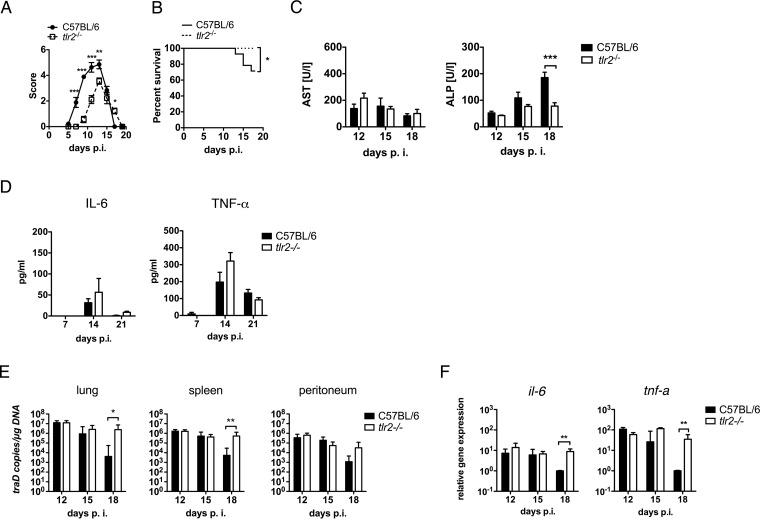FIG 5.
TLR2-competent mice show higher levels of susceptibility to a lethal outcome, which is associated with a more efficient reduction of bacterial loads and increased serum ALP levels but not prolonged inflammation. C57BL/6 and tlr2−/− mice were infected i.p. with 5,000 SFU of O. tsutsugamushi. (A) Clinical scores were determined at the indicated time points p.i. (pooled results from two independent experiments, n = 9, mean ± SEM). (B) Kaplan-Meier curves show the survival of i.p. infected C57BL/6 and tlr2−/− mice. Data from three independent experiments were pooled (n = 15). (C) AST and ALP concentrations (n = 5 to 8) in serum samples obtained at the indicated times were measured using Reflotron colorimetric analysis (pooled results from two independent experiments, n = 5 to 8, mean ± SEM). (D) Serum concentrations of IL-6 (left) and TNF-α (right) were measured by use of a cytokine bead array on days 7, 14, and 21 p.i. (n = 3, mean ± SEM). (E) Bacterial loads in the lung, spleen, and peritoneum were measured by traD qPCR on days 12, 15, and 18 p.i. (n = 7 to 8, data pooled from two independent experiments, mean ± SEM). (F) RNA was extracted from peritoneum samples obtained on days 12, 15, and 18 p.i., and the relative expression of il-6 and tnf-a mRNA was measured by quantitative real-time PCR (n = 4, means ± SEMs). *, P < 0.05 by two way-ANOVA (A and C to E); **, P < 0.01 by two way-ANOVA (A and C to E); ***, P < 0.001 by two way-ANOVA (A and C to E); *, P < 0.05 by log-rank (Mantel-Cox) test (B).

